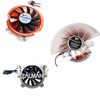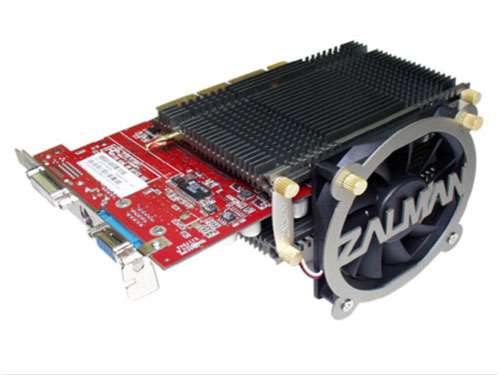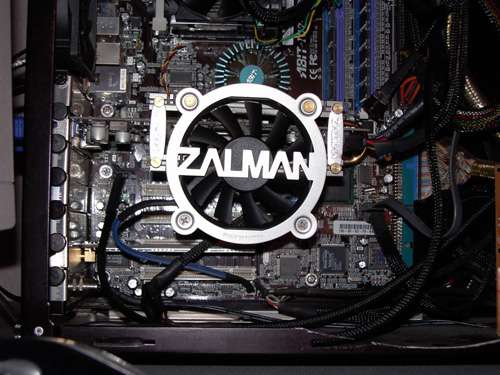- Qualcomm Launches Snapdragon 4 Gen 2 Mobile Platform
- AMD Launches Ryzen PRO 7000 Series Mobile & Desktop Platform
- Intel Launches Sleek Single-Slot Arc Pro A60 Workstation Graphics Card
- NVIDIA Announces Latest Ada Lovelace Additions: GeForce RTX 4060 Ti & RTX 4060
- Maxon Redshift With AMD Radeon GPU Rendering Support Now Available
VF900-Cu vs. Fatal1ty FS-V7 vs. ZM80C-HP Round-Up

Page 1 – Introduction & ZM80C-HP2
Unless you just flew in from Alpha Centauri you have probably heard of Zalman which is a name long associated with air cooling in a wide range of products. Of course they make more than just coolers including PSU’s, Cases, H2o systems and more. Air cooling is the most affordable way for most folks to keep their system temps under control and there are as many designs as there are manufacturers. Zalman has been innovative in their designs and material choices for as long as I can remember.
As listed above the three combatants are the VF900-Cu, the Fata1ty FS-V7, and the older of the three the ZM80C-HP with the optional ZM-OP1 fan. Now if you’re wondering about why the ZM80C is included here it’s for two reasons. First I happen to have it on my 9800 at the time of this review and second, I was curious as to how well it will hold up against it’s newer competition. So let’s get on with it, shall we?
The test platform is an ATI 9800 overclocked to an XT on an Intel system. The mobo is the Abit IC-7 Max 3 With a P-4 Northwood 2.66 @ stock settings for this review. 1 GB’s of DDR pc 3200. I used Aqua Mark3 and 3D Mark 06 to obtain the results. The conditions for all three tests were the same within .5 degrees as far as the ambient room temperature was concerned which was 21.1 celsius or 70 degrees fahrenheit for those of us in the U.S of A. Because I had a better thermal paste than what came with the ZM80C originally, I felt I should do the same for the other two cards. I had used Arctic Silver 3 on the ZM80-C. Unfortunately I only had Arctic Silver 5 to use on the other two cards.
Let’s take a look at the older of the three and see what it can do. Remember this came out in the latter part of 2002. This thing is heavy by today’s standards, weighing in at a hefty 325 grams and another 75 grams for the optional fan kit making a grand total of 400 grams. Here’s what Zalman had to say about it.
- Features
- 1. By utilizing a heat pipe, the GPU (Graphics Processing Unit, a.k.a. Video Chipset) can be cooled without a fan.
- 2. The fan less design ensures complete noiselessness and permanent, maintenance-free operation.
- 3. It can be used on virtually all kinds of video cards, so it can be reused with upgraded video cards. (Note: The video cards without the heatsink mounting holes or with components that interfere with the heatsink cannot accommodate this product.)
- 4. This product can have a noiseless fan (ZM80C Optional Package ‘ZM-OP1’; sold separately) attached to the heatsink without using a bracket.
- 5. By attaching the noiseless fan (ZM-OP1), the video chipset, as well as the memory chips on both side of the video card gets cooled for a more stable operation of the video card.
- Specifications
- Weight: 325g
- Heat pipe: Gold Plated Copper
- Tube Dissipate. Material: Aluminum
- Dissipate. Area: 1200
- Dimensions: 80 (L) X 80 (W) X15 (H) mm
- Weight : 75g
- Fan Speed: Silent Mode 1400 RPM ± 10% Normal Mode 2800 RPM ± 10%
- Noise Level: Silent Mode 20.0dB ± 10% Normal Mode 33dB ± 10%
- Bearing Type: 2-Ball
- MTBF: 50,000 hrs.
- Grill: 80 mm
- Multi-Connector: ZM-MC1 (3-Pin)
- ZM-OP1 Fan Specifications:
Man there were parts and more parts. I remember when I installed it originally I thought it was a bit complicated. And the application of the thermal paste on the heat pipes was different at the time for sure.
Let’s look at the results:
- @ Idle the temps were 37 degrees celsius.
- Aqua Mark3 the temps were 41 degrees celsius.
- 3D Mark 06 the temps were 42 degrees celsius.
Well I can’t really give you a review quality conclusion here because I did not do an original review of this cooler but we are doing a comparison between the three to help gauge how far VGA coolers have come to date.
|
|
Support our efforts! With ad revenue at an all-time low for written websites, we're relying more than ever on reader support to help us continue putting so much effort into this type of content. You can support us by becoming a Patron, or by using our Amazon shopping affiliate links listed through our articles. Thanks for your support!






